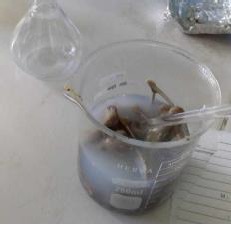fsm.undip.ac.id / Plastic is often used as a wrapper for a good food or beverage product. However, the use of plastic has become a common concern because of its non-biodegradable nature. This is the basis of three students of the Faculty of Science and Mathematics (FSM). With the right composition accompanied by trial steps, Pipit Riyanti as chairman managed to bring his team los funding for the student creativity Program (PKM) in 2019 by the Ministry of research and Technology (Kemenristekdikti) under the guidance of Bpk. Not Based on a promise, S.SI., M.Sc., Ph.D
Originator Of The Idea
The campaign to reduce plastic waste is well underway. plastic as the main waste in Indonesia will have an impact in various aspects. starting from this condition, Pipit Riyanti and two partners namely Setiya Rahayu and Kharisma Madda El-Iyana sparked the idea of making edible films. Edible film is a packaging of a product that can be consumed directly. uniquely, the main ingredient used to make edible film is chicken bone.
Chicken bones are one of the leftovers that are often overlooked. However, it turns out that chicken bones can be used as herbal packaging materials ready for consumption. Madda as a member of the team claimed to choose chicken bones because they contain collagen that can be used as a basic ingredient for making edible film. Collagen can also help increase the elasticity of the skin so that the packaging can be easily torn off and used.
Besides because there is collagen in chicken bones, the three Chemistry Department students also argue that chicken bones become waste that is rarely recycled. in addition, Tembalang Semarang area and the restaurant industry that makes chicken as a menu dish. therefore, the main ingredient of chicken bone is chosen because its availability is quite a lot and easy to find. By using chicken bones as packaging materials, the waste produced can be decomposed naturally and does not cause adverse effects on the environment.

Setiya explained in this study, how they processed and used chicken bone waste for their research. To process chicken bones into ready-to-consume herbal medicine packaging materials, chicken bones must first be washed and boiled until tender. After that, the chicken bones are taken out of the meat and separated from the bones. The clean chicken bones are then cut into pieces of the desired size.
Next, the chicken bones are processed using the drying or oven method to remove moisture from the bones. After the chicken bone is dry, the chicken bone can be used as a ready-to-consume herbal medicine packaging material. In use, chicken bones can be used as capsule containers or sachets filled with herbs ready for consumption.
In conclusion, chicken bones are leftover foodstuffs that can be used as herbal packaging materials ready for consumption. The use of chicken bones as packaging materials has several advantages such as containing good collagen to maintain the quality of packaging, and is an alternative to environmentally friendly plastic packaging materials. Therefore, the use of chicken bones as packaging materials can be the right choice to minimize waste and help maintain the environment.
Although at this time pengplikasian edible film using chicken bones results from research and both partners Sparrow new herbal products, but did not rule out the possibility will be applied to other materials. (yeye)

